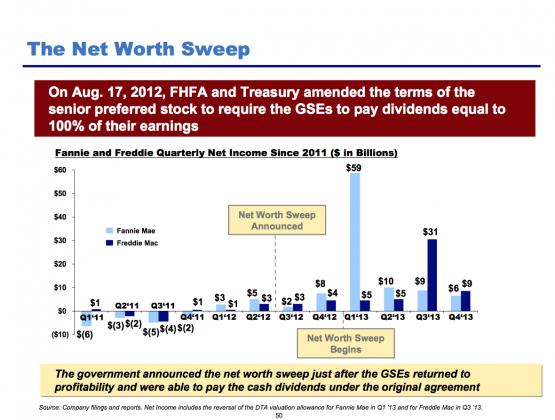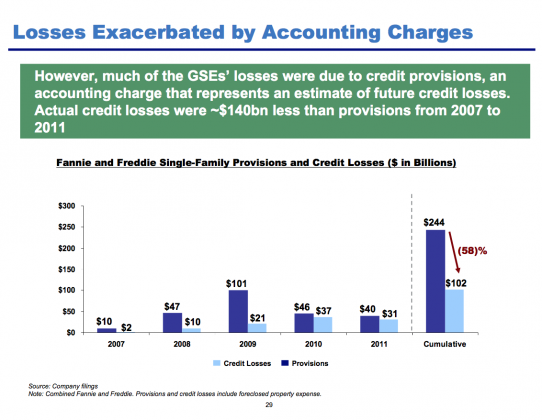This is by no means for the GSE’s the irrelevant ruling some take it to be and also by no means the slam dunk others tout it as. I’ll skip the hyperbole and try to get at the good/bad of it. At best this ruling is a blueprint for the GSE’s ($FNMA) cases, at its worst, it is irrelevant. (Wheeler Ruling)
Let’s look at the basics:
The main issues in the case are: (1) whether the Federal Reserve Bank of New York possessed the legal authority to acquire a borrower’s equity when making a loan under Section 13(3) of the Federal Reserve Act, 12 U.S.C. § 343 (2006); and (2) whether there could legally be a taking without just compensation of AIG’s equity under the Fifth Amendment where AIG’s Board of Directors voted on September 16, 2008 to accept the Government’s proposed terms. If Starr prevails on either or both of these questions of liability, the Court must also determine what damages should be awarded to the plaintiff shareholders.
The equity argument is bunk for the GSE’s because as I read HERA Treasury had the authority to take equity when they placed the GSE’s into conservatorship and then provided bailout terms. While some look at that as a bad thing, it is actually very good. Starr lost their 5th Amendment case because the Fed did NOT have authority to takes shares when they bailed out $AIG. As the Judge said:
A ruling in Starr’s favor on the illegal exaction claim, finding that the Government’s takeover of AIG was unauthorized, means that Starr’s Fifth Amendment taking claim necessarily must fail. If the Government’s actions were not authorized, there can be no Fifth Amendment taking claim.
The GSE litigation does NOT challenge the ability of the government to place the GSE’s into conservatorship. The “action” the government took was legal as it was authorized under HERA. That means we have the door opened to a 5th amendment claim. When one compares this ruling to the GSE litigation, one not ought to be looking at the conservatorship itself but its terms, and 2012, when the 3rd amendment was announced. In the GSE cases, the “taking” is not the shares they obtained or the share price when the NWS was enacted. The taking is $200B in profits and counting since then.
From Judge Wheeler:
The weight of the evidence demonstrates that the Government treated AIG much more harshly than other institutions in need of financial assistance. In September 2008, AIG’s international insurance subsidiaries were thriving and profitable, but its Financial Products Division experienced a severe liquidity shortage due to the collapse of the housing market. Other major institutions, such as Morgan Stanley, Goldman Sachs, and Bank of America, encountered similar liquidity shortages. Thus, while the Government publicly singled out AIG as the poster child for causing the September 2008 economic crisis (Paulson, Tr. 1254-55), the evidence supports a conclusion that AIG actually was less responsible for the crisis than other major institutions. The notorious credit default swap transactions were very low risk in a thriving housing market, but they quickly became very high risk when the bottom fell out of this market. Many entities engaged in these transactions, not just AIG. The Government’s justification for taking control of AIG’s ownership and running its business operations appears to have been entirely misplaced. The Government did not demand shareholder equity, high interest rates, or voting control of any entity except AIG. Indeed, with the exception of AIG, the Government has never demanded equity ownership from a borrower in the 75-year history of Section 13(3) of the Federal Reserve Act. Paulson, Tr. 1235-36; Bernanke, Tr. 1989-90.
This is important. The GSE’s cannot be the sole scapegoat for what happened in 2008. Did they play a role? Most certainly but as the Judge above noted, they were by no means alone. The question then turns to the terms of the assistance. The GSE’s were given a total of $185B in backing from the Fed government at 10% with the government also taking a 79.9% stake. The equity stake, unlike in the $AIG case is not an issue. Were the terms fair?
It is pretty clear the GSE’s were force fed ~2X the amount of assistance they actually needed during the crisis. Further, while the rate they paid (10%) was not outlandish at the time, the inability to payback that assistance was unheard of in every other assistance package put together during the crisis. Here, the argument can be made that the terms were also unduly harsh when looked at compared to every other aid package out there. What did HERA say about Treasury assistance?
‘‘(l) TEMPORARY AUTHORITY OF TREASURY TO PURCHASE OBLIGATIONS AND SECURITIES; CONDITIONS.—
‘‘(1) AUTHORITY TO PURCHASE.—
‘‘(A) GENERAL AUTHORITY.—In addition to the authorityunder subsection (c) of this section, the Secretary of the Treasury is authorized to purchase any obligations and other securities issued by the Corporation under any section of this Act, on such terms and conditions as the Secretary may determine and in such amounts as the Secretary may determine. Nothing in this subsection requires the Corporation to issue obligations or securities to the Secretary without mutual agreement between the Secretary and the Corporation. Nothing in this subsection permits or authorizes the Secretary, without the agreement of the Corporation, to engage in open market purchases of the common securities of the Corporation.
‘‘(B) EMERGENCY DETERMINATION REQUIRED.—In connection with any use of this authority, the Secretary must determine that such actions are necessary to—
‘‘(i) provide stability to the financial markets;
‘‘(ii) prevent disruptions in the availability of mortgage finance; and
‘‘(iii) protect the taxpayer.
‘‘(C) CONSIDERATIONS.—To protect the taxpayers, theSecretary of the Treasury shall take into consideration the following in connection with exercising the authority contained in this paragraph:
‘‘(i) The need for preferences or priorities regarding payments to the Government.
‘‘(ii) Limits on maturity or disposition of obligations or securities to be purchased.
‘‘(iii) The Corporation’s plan for the orderly resumption of private market funding or capital market access.
‘‘(iv) The probability of the Corporation fulfilling the terms of any such obligation or other security, including repayment.
‘‘(v) The need to maintain the Corporation’s status as a private shareholder-owned company.
The condition of repayment without Treasury authorization (and Treasury refusing to do so) does not follow HERA’s specifically stated requirement that the GSE’s could in fact do so. Further, condition (v) runs counter to the GSE’s now being nationalized with Treasury taking all the profits.
Judge Wheeler:
The Government’s unduly harsh treatment of AIG in comparison to other institutions seemingly was misguided and had no legitimate purpose, even considering concerns about “moral hazard.” The question is not whether this treatment was inequitable or unfair, but whether the Government’s actions created a legal right of recovery for AIG’s shareholders…….
In the end, the Achilles’ heel of Starr’s case is that, if not for the Government’s intervention, AIG would have filed for bankruptcy. In a bankruptcy proceeding, AIG’s shareholders would most likely have lost 100 percent of their stock value.
As the Court noted during closing arguments, a troubling feature of this outcome is that the Government is able to avoid any damages notwithstanding its plain violations of the Federal Reserve Act. Closing Arg., Tr. 69-70. Any time the Government saves a private enterprise from bankruptcy through an emergency loan, as here, it can essentially impose whatever terms it wishes without fear of reprisal. Simply put, the Government often may ignore the conditions and restrictions of Section 13(3) knowing that it will never be ordered to pay damages. With some reluctance, the Court must leave that question for another day. The end point for this case is that, however harshly or improperly the Government acted in nationalizing AIG, it saved AIG from bankruptcy. Therefore, application of the economic loss doctrine results in damages to the shareholders of zero.
This is huge. The 3rd amendment did NOT save the GSE’s from bankruptcy. In fact when it was announced it was obvious to everyone that they were about to become hugely profitable from the very mistake the government made in grossly overestimating the losses they would incur. In reality the GSE’s were under no obligation to ever pay the Treasury a single penny of the bailout. They could have simply paid them in-kind in additional common stock. 
So, in the GSE case, we have a 5th amendment claim as Treasuries/FHFA’s actions were authorized, we have unduly harsh terms AND, (this is the most important) we have a taking of ~$200B in profits since the 3rd amendment was enacted. Supporters of the government will react by saying “HERA essentially said the government could do what it wanted to”. We will put aside the fact that the government only really needed 1 page to say that, not the 261 they took painstakingly laying out HERA’s boundaries. HERA (pdf) and focus on what Judge Wheeler says…..
Judge Wheeler:
Having considered the entire record, the Court finds in Starr’s favor on the illegal exaction claim. With the approval of the Board of Governors, the Federal Reserve Bank of New York had the authority to serve as a lender of last resort under Section 13(3) of the Federal Reserve Act in a time of “unusual and exigent circumstances,” 12 U.S.C. § 343 (2006), and to establish an interest rate “fixed with a view of accommodating commerce and business,” 12 U.S.C. § 357. However, Section 13(3) did not authorize the Federal Reserve Bank to acquire a borrower’s equity as consideration for the loan. Although the Bank may exercise “all powers specifically granted by the provisions of this chapter and such incidental powers as shall be necessary to carry on the business of banking within the limitations prescribed by this chapter,” 12 U.S.C. § 341, this language does not authorize the taking of equity. The Court will not read into this incidental powers clause a right that would be inconsistent with other limitations in the statute. Long ago, the Supreme Court held that a federal entity’s incidental powers cannot be greater than the powers otherwise delegated to it by Congress. See Fed. Res. Bank of Richmond v. Malloy, 264 U.S. 160, 167 (1924) (“[A]uthority to do a specific thing carries with it by implication the power to do whatever is necessary to effectuate the thing authorized – not to do another and separate thing, since that would be, not to carry the authority granted into effect, but to add an authority beyond the terms of the grant.”); see also First Nat’l Bank in St. Louis v. Missouri, 263 U.S. 640, 659 (1924) (“Certainly, an incidental power can avail neither to create powers which, expressly or by reasonable implication, are withheld nor to enlarge powers given; but only to carry into effect those which are granted.”); Suwannee S.S. Co. v. United States, 150 Ct. Cl. 331, 336, 279 F.2d 874, 876 (1960) (“No statute should be read as subjecting citizens to the uncontrolled caprice of officials.”).
Wheeler plainly states that the “we had to do it because there was a crisis” excuse that permeates every single filing from the government in the GSE cases does not hold water.
Specifically: “No statute should be read as subjecting citizens to the uncontrolled caprice of officials”. The conservatorship was to “preserve and protect” the assets of the GSE’s. It was not to wind them down and for the government to be able to confiscate the profits. HERA has rules and boundaries and the constitution cannot be set aside to achieve a means.
If you take $200B in shareholder profits, they are to be compensated for it.
